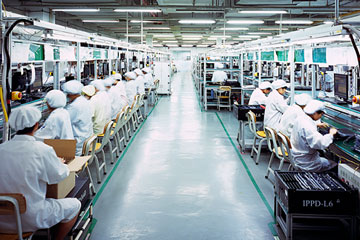
A Foxconn plant in Shenzhen, which puts together, among other products, the iPhone.
(3 of 7)
Rising costs are even making China less competitive compared with the U.S. The decision to offshore production to China was once almost automatic for American executives--high costs in the U.S. made staying almost impossible. But that is no longer true. Boston Consulting Group (BCG) figures that, taking into account rising wages, labor productivity and other factors, the cost of manufacturing in China will roughly equal that in the U.S. by 2015. No wonder a BCG survey of large U.S. manufacturers, released in September, showed that 21% of the respondents were either actively bringing production back to America from China--a process known as reshoring--or planning to do so over the next two years.
Michael Araten, president of toymaker K'NEX, began reshoring in 2009 to preserve jobs at his Hatfield, Pa., factory during the Great Recession. Examining the operations, Araten came to realize that manufacturing in China was not as efficient as the firm had believed. There was what he calls the China handicap--the added burden of large inventories, inflexible supply chains and missed market opportunities caused by long-distance production. By investing in automation, K'NEX has been able to return almost all of its parts production and most of its finished-product assembly back to Hatfield while maintaining profitability. "China is at an inflection point," says Araten. "The world inverted over the past 30 years and China benefited. Now it is inverting again, and America is the beneficiary."
Not just foreign companies are looking to ship out. Last year, footwear maker Huajian, based in the southern industrial town of Dongguan, invested $15 million for a factory in Ethiopia, attracted by wages one-eighth of those in its Chinese plants. Over the next five years, Huajian plans to expand its workforce in the African nation from 2,800 employees to 30,000. Huajian chairman Zhang Huarong believes Chinese shoemakers need to do more than compete on cost to ensure China's future in the industry--they must focus on R&D and improving productivity. "Before, the model was to follow the cheap labor, but now Chinese companies should change their attitude," he says.
COMPANIES LAG BEHIND IN TECHNOLOGY.
Some Chinese companies, most notably telecom-equipment maker Huawei, are globally competitive. But they are rare. Most lag behind in critical technology. Ask Li Shufu, founder of Hangzhou-based Geely. In 2006, Geely made history by becoming the first Chinese automaker to display a model at the North American International Auto Show in Detroit. Back then, the hard-charging Li had a grand plan to export his small sedans to U.S. consumers. That never happened. Li wisely decided his cars simply weren't ready to compete in the tough American market. "Geely needs to improve in many aspects: skills, quality, maintenance, management," he admits.
